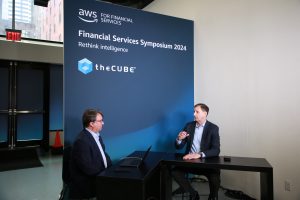 AI
AI
 AI
AI
 AI
AI
Generative artificial intelligence is set to revolutionize the financial services industry, marking a confluence of technology and business operations. While the sector has utilized AI for decades, factors such as the rise of AI factories, accelerated compute platforms and purpose-built infrastructures signal a technical expansion by orders of magnitude.

Discussing gen AI for financial services with Nvidia’s Malcolm deMayo.
“There is a tsunami-sized wave of innovation, disruptive innovation,” said Malcolm deMayo (pictured), global vice president of the financial services industry at Nvidia Corp. “In financial services … between the front office, middle office and back office, there are literally hundreds of opportunities for firms to leverage generative AI to improve productivity and operational efficiency and to drive new revenue streams. But they can’t do that on their existing systems — they need to transform their data centers … to AI factories.”
DeMayo spoke with theCUBE’s John Furrier at the AWS Financial Services Symposium, during an exclusive broadcast on theCUBE, SiliconANGLE Media’s livestreaming studio. They discussed gen AI and the steps financial services companies must take to harness its transformative potential. (* Disclosure below.)
A key component of this transformation is the concept of the AI factory — a combination of advanced hardware, software and development platforms designed to handle the massive computational demands of AI workloads.
“An AI factory is a combination of a completely new stack of systems,” deMayo said. “It’s also leveraging open-source models, APIs or OpenAPIs. Then, finally, it’s having the stack in place. What Nvidia has done is we’ve built a complete full-stack platform to help financial services tackle this.”
Traditional data centers are ill-equipped to manage these new requirements. Instead, firms need to overhaul their infrastructure, adopting AI-ready systems that can support the intensive processing needs of generative AI, according to deMayo.
“The first thing that goes away is yesterday’s computers,” he said. “Cloud has really saved the day. Moore’s law, or maybe said differently, CPU scaling has ended. When you have software as demanding as generative AI, as models have grown 3600x in the last 10 years — some of our customers have exabyte-size datasets — as we build a faster accelerated compute platform, the software becomes more demanding.”
Here’s the complete video interview, part of SiliconANGLE’s and theCUBE Research’s coverage of the AWS Financial Services Symposium:
(* Disclosure: Amazon Web Services Inc. and Nvidia Corp. sponsored this segment of theCUBE. Neither AWS and Nvidia nor other sponsors have editorial control over content on theCUBE or SiliconANGLE.)
THANK YOU